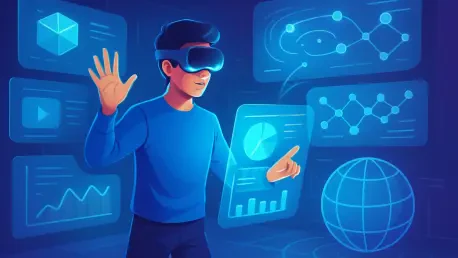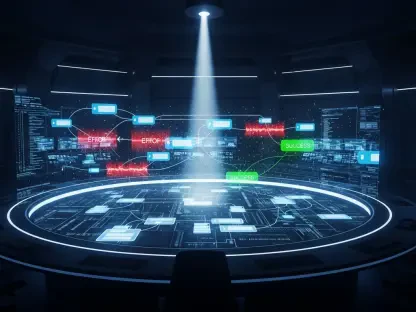In the rapidly advancing landscape of technology, spatial computing serves as a bridge that seamlessly connects the physical and digital worlds. This sophisticated technological advancement leverages immersive technologies such as Augmented Reality (AR), Virtual Reality (VR), and Mixed Reality (MR) to craft interactive experiences where digital content and human presence coexist naturally. Unlike traditional interfaces, spatial computing fosters an environment where users can engage with digital content in a manner akin to how they interact with the physical world. This evolution in human-computer interaction moves beyond passive screen engagement, inviting users to navigate digital environments actively using voice commands, eye movements, and subtle gestures, which heightens their participation and connection to digital experiences. The article delves into the profound shifts occurring within commercial sectors as they begin to adopt these immersive technologies, reshaping industries ranging from automotive to finance and healthcare, thereby positioning spatial computing as a catalyst for change and innovation across diverse fields.
The Redefinition of Human-Computer Interaction
Spatial computing marks a pivotal shift in how humans interact with technology, pushing beyond traditional desktop interfaces that require users to conform to computer-driven environments. In contrast, it encourages technology to adapt to human behaviors and natural interactions, creating a more user-centric experience. This transformative approach radically changes the dynamic between humans and machines, allowing for more intuitive interactions that feel less like a chore and more like an extension of natural human behavior. Voice commands, eye-tracking, head movements, and finger gestures become integral to this interaction, effectively bringing digital content to life in a 3D space that mirrors real-world environments. Industry leaders like Ivan Gerard Khoo from Ministry XR advocate this design philosophy, emphasizing the harmonization of technological interfaces with fundamental human actions and understanding. The ultimate goal is to craft hyper-individualized experiences that not only enhance user engagement but also broaden accessibility by making technology inherently more intuitive for a wider audience.
The Rise of Immersive Technologies in Industries
With the increasing commercial adoption of AR, VR, and MR across various industries, spatial computing is starting to influence the very fabric of business operations and consumer engagement. In the automotive sector, for instance, companies are utilizing these technologies to redefine customer experiences during vehicle test drives. Ford’s collaboration with Ministry XR exemplifies the use of VR headsets to create an immersive simulation of their vehicles, offering potential buyers a compelling and informative experience that greatly enhances brand perception and drives sales. In the medical field, VR presents unprecedented opportunities for researchers, enabling them to explore and analyze molecular structures in a 3D format, fostering deeper collaboration in drug development processes. The finance sector also looks towards immersive technologies to develop dynamic trading environments where vast streams of data are accessed and interacted with in real-time, thereby transforming complex information into actionable insights. These innovations underscore the utility and transformative potential of spatial computing in reimagining business models and delivering sophisticated, engaging user experiences.
Beyond Technical Advancements: Enriching User Experience
The benefits of spatial computing extend beyond mere technical achievements, reshaping user expectations in an experience-driven economy. As industries increasingly embrace these technologies, there is a growing trend toward delivering meaningful, interactive experiences that resonate with consumers on a deeper level. This shift reflects a broader cultural movement away from pure consumption habits toward experiences that are both engaging and personalized. Spatial computing allows for the creation of immersive environments that captivate the user, offering solutions that are not only intuitive and engaging but also borderless and cost-effective. Marketers and brand strategists have begun to leverage XR technologies to enrich brand storytelling, intertwining narratives with interactive elements that speak to the consumer’s desire for personalized experiences. Industry insights from experts like Kimberley Yap, V.P. of XR Experience Design, highlight the transformative power of these user-focused interactions, affirming the vital connection between technology’s capability to create memorable experiences and consumer expectations in the digital age.
The Future of XR and Mainstream Adoption
As spatial computing technologies evolve, there is a growing focus on achieving seamless integration with human interactions, seeking to transcend physical and environmental constraints. The current hurdle involves refining AR headsets to a level of comfort and miniaturization sufficient for widespread adoption. However, the prospects for mobile-embodied AR are optimistic, with continuous innovations pushing these technologies toward becoming mainstream accessories. This transition involves addressing challenges related to hardware adaptability, ensuring that these devices are not only accessible but also contextually relevant in everyday life. As accessibility and connectivity improve, it is anticipated that spatial computing will become a regular aspect of daily routines, fundamentally altering how individuals access and interact with digital information. The path forward suggests a burgeoning potential where technology seamlessly embeds into human environments, offering avenues for both individual enrichment and broader societal enhancements.
Embracing a New Era of Digital Interaction
In today’s fast-paced technological landscape, spatial computing acts as a bridge seamlessly linking the physical and digital worlds. This advanced technology uses immersive tools like Augmented Reality (AR), Virtual Reality (VR), and Mixed Reality (MR) to create interactive experiences where digital content and people coexist naturally. Unlike conventional interfaces, spatial computing nurtures an environment where users can interact with digital content much like they do with the real world. This shift in human-computer interaction moves beyond simple screen engagement, encouraging users to explore digital spaces actively through voice commands, eye movements, and subtle gestures. This enhances their participation and connection to the digital realm. The article explores significant changes within commercial sectors as they start embracing these immersive technologies. Industries from automotive to finance, healthcare, and more are being reshaped, making spatial computing a key driver of innovation and transformation across various fields.









